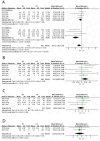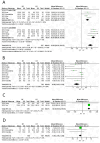A meta-analysis of unilateral axillary approach for robotic surgery compared with open surgery for differentiated thyroid carcinoma
- PMID: 38603661
- PMCID: PMC11008900
- DOI: 10.1371/journal.pone.0298153
A meta-analysis of unilateral axillary approach for robotic surgery compared with open surgery for differentiated thyroid carcinoma
Abstract
Objective: The Da Vinci Robot is the most advanced micro-control system in endoscopic surgical instruments and has gained a lot of valuable experience today. However, the technical feasibility and oncological safety of the robot over open surgery are still uncertain. This work is to systematically evaluate the efficacy of the unilateral axillary approach for robotic surgery compared to open surgery for differentiated thyroid carcinoma.
Methods: PubMed, Embase, Cochrane Library, and Web of Science databases were utilized to search for relevant literatures of robotic thyroid surgery using unilateral axillary approach compared to open thyroid surgery, and a meta-analysis was performed using RevMan software version 5.3. Statistical analysis was performed through Mantle-Haenszel and inverse variance methods.
Results: Twelve studies with a total of 2660 patients were included in the meta-analysis. The results showed that compared with the open group, the robotic group had a longer total thyroidectomy time, shorter hospital stay, less intraoperative bleeding, more postoperative drainage, fewer retrieved central lymph nodes, and higher cosmetic satisfaction (all P < 0.05). In contrast, temporary and permanent laryngeal recurrent nerve injury, temporary and permanent hypoparathyroidism or hypocalcemia, brachial plexus nerve injury, number of retrieved central lymph nodes, number of retrieved lymph nodes in the lateral cervical region, number of lymph node metastases in the lateral cervical region, hematoma, seroma, lymphatic leak, stimulated thyroglobulin (sTg) and unstimulated thyroglobulin (uTg), and the number and recurrence rate of patients with sTg <1ng/ml were not statistically different between the two groups (P > 0.05).
Conclusions: The unilateral axillary approach for robotic thyroid surgery may achieve outcomes similar to those of open surgery. Further validation is required in a prospective randomized controlled trial.
Copyright: © 2024 Zhang et al. This is an open access article distributed under the terms of the Creative Commons Attribution License, which permits unrestricted use, distribution, and reproduction in any medium, provided the original author and source are credited.
Conflict of interest statement
NO.
Figures






References
Publication types
MeSH terms
Substances
LinkOut - more resources
Full Text Sources
Medical
Miscellaneous

